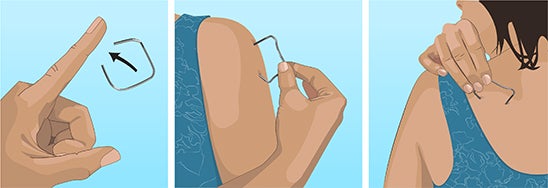Easy Nervous System Lab for Middle School
Written by: Brittany Sanner
Illustrated by: Sabine Deviche and James Baxter
How do you know when your hand touches something? How do you know if something brushes against your shoulder? As you learned in A Nervous Journey, some of the neurons of the nervous system sense things in the environment and send those signals to the brain for analysis. Each neuron can only send one signal at a time. If two points touch the same neuron, it can still only send one signal to the brain. This means, your brain would only sense one thing touching you, even when there are two.
Knowing this, do you think you need the same number of nerves in every part of your body? Think about your fingertip, arm and back. In which of these places might your nerves be closer together? Make your predictions and see for yourself in the experiment below!
Form a Hypothesis
Predict which part of your body (fingertip, arm or shoulder) will be most sensitive and explain why.
What You Need
- 1 ruler that shows centimeters
- 1 paperclip (unwound so it looks like a square and the ends are together)
- Paper and pencil
Procedures

Before you begin:You will need a table to record your data, similar to the one above. You can use your pencil and paper to draw your table, or download and print out the Nerve Experiment (PDF).
Make a table with 4 columns and 10 rows. Title the columns "Distance Between Paperclip Ends", "Fingertip", "Upper arm", and "Back."
To fill in the distances, start at 4cm and go down by one half centimeter for every row - 4cm, 3.5cm, 3cm, and so on. The last row should say "ends touching." Now you are ready to get started!
 Step 1:Open the paperclip as shown above. Spread the ends and use the ruler to measure the distance between them. Adjust them until they are exactly 4cm apart.
Step 1:Open the paperclip as shown above. Spread the ends and use the ruler to measure the distance between them. Adjust them until they are exactly 4cm apart.

Step 2: Touch both ends of the paper clip to your finger tip. A gentle touch is all that is required.
If you feel both ends, write a "2" in the first square in the chart as shown in the example above. If you only feel one paper clip end, that means both ends of the paper clip are touching the same neuron. If this happens, write a "1" in the appropriate square in your table.
Step 3: Repeat this on your upper arm and back, and record your results in your table. (Hint: If you have a hard time reaching your back, ask a partner for help.)
Step 4: Using your ruler, push the paper clip ends 1/2 centimeter closer together. Repeat steps 2 and 3, bringing the paper clip ends closer each time until they are touching.
Analysis and Conclusions
- What was the independent variable in this experiment? How do you know?
- What was the dependent variable in this experiment? How do you know?
- What patterns did you see in your data?
- Which part of the body was least sensitive?
- Which part of the body is most sensitive? Why do you think that is?
- Was your hypothesis supported? Why or why not? Use your data to explain your answer.
- What further questions does this experiment raise, and what could you do to investigate the answers to those questions?
Most people will feel both ends of the paper clip when they are 4 centimeters apart almost everywhere on the body, but once those paper clip ends get closer together, that starts to change. Some parts of the body will begin to feel only one end. Most people find that their fingers are most sensitive and their backs are least sensitive.
Why do you think fingers would be most sensitive? What do you use your fingertips for? Apart from the usual desire to touch things - especially prominent in museums and efforts to annoy your brother or sister - people have been using their sensitive fingers for some very practical purposes. Babies learn, artists perfect their masterpieces, chefs check the sharpness of their knives all with the sensitivity of their fingers. The blind have even been using their fingers to read braille since its invention by Louis Braille in the 1800's. Can you do that with your upper arm or back?
Brittany Sanner is a Robert Noyce scholar and a graduate of Arizona State University. She teaches biology and chemistry at Central High School in Phoenix Arizona.
Additional images via Wikimedia Commons. Colored mouse nervous tissue via ZEISS Microscopy.
Source: https://askabiologist.asu.edu/experiments/nerves
0 Response to "Easy Nervous System Lab for Middle School"
Post a Comment